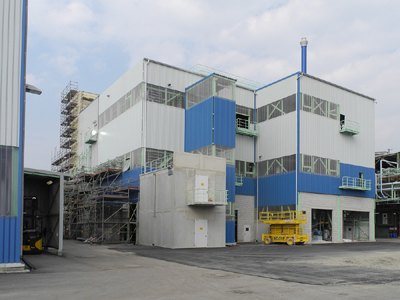Clariant is today opening a second production unit for the successful flame retardant (FR) Exolit® OP at the Hürth-Knapsack plant near Cologne. The established non-halogenated additive is used primarily in the electronics and electrical engineering (E&EE) sector,. The new facility doubles the capacity for DEPAL (diethyl phosphinic acid aluminum salt)-based FRs.
 Clariant has doubled the capacity for its environmentally compatible, non-halogenated flame retardant Exolit OP in Hürth-Knapsack. (Photos: Clariant)
Clariant has doubled the capacity for its environmentally compatible, non-halogenated flame retardant Exolit OP in Hürth-Knapsack. (Photos: Clariant)
Clariant has established itself as a world leader in non-halogenated flame retardants. By doubling the DEPAL capacity in Hürth, the company is responding to the growing demand for safe and environmentally friendly FRs for plastics in the global E&EE market. Exolit OP (based on organophosphorous compounds) has been manufactured at the Hürth-Knapsack plant since the product line was launched in 2004.
The efficient infrastructure of the Knapsack Chemical park and the central location of the site close to Cologne provide a solid basis for reliable and safe production, and ensure a high level of delivery reliability for customers.
“The strength of demand is demonstrated by the constant increase in utilization since production got underway,” says Michael Grosskopf. “The environmental and safety awareness of our customers has increased considerably, resulting in growing demand for our non-halogenated flame retardants. Key customers are indicating that their requirements will see further strong increases in the years ahead. This timely expansion of our production capacity means that we are ideally positioned to meet this demand.”
Global growth in demand in a range of applications
Exolit OP has proven successful as a halogen-free flame retardant , particularly for engineering thermoplastics such as polyamides and polyesters, and is used in switches, plugs, PC fans, and structural and housing components. Smartphones, washing machines, and airplane parts, among others, contain the product. Other applications include thermosetting resins as well as cable sheaths and insulation made from thermoplastic elastomers. Exolit can give these plastics flame retardant properties that are otherwise only achievable with expensive high-performance plastics which are less easy to work with.
In most cases, a relatively small dose is sufficient to meet the strict fire protection regulations applicable in these market segments, as well as to comply with all environmental legislation such as European Directive 2011/65/EU on the Restriction of Hazardous Substances (RoHS) in electrical and electronic equipment or European Directive 2012/19/EU on Waste Electrical and Electronic Equipment (WEEE).
Clariant has developed two new non-halogenated FRs in Hürth-Knapsack under the name Exolit EP specifically for the flame retardancy of epoxy resins. Both products are aimed at the requirements of printed circuit boards and therefore perform vital functions such as minimizing the impact of the FR on the glass transition temperature of the plastic, which is a key parameter in epoxy resin chemistry in this demanding application. In addition, it has been shown that Exolit EP can reduce the quantity of flame retardant required by up to 50% compared with conventional products.
Alongside the Exolit OP and EP product families, Clariant also manufactures the Exolit AP flame retardant, which is based on ammonium polyphosphates (AP). This FR renders polyolefins fit for use in electrical and electronic items and increases the fire resistance time of steel/building structures. Further product groups include Exolit RP, based on red phosphorous in various formulations and dosage forms for polyamides, and Exolit 5060, used for viscose fibers for protective and safety clothing.
“Exolit can be formulated to create a tailored flame retardant system based on product requirements and customer specifications, in either its product form or in synergistic combination with other supporting substances,” says Dr. Adrian Beard, Head of Marketing FR at Clariant. “Together with its cost effectiveness, this makes Exolit perfectly positioned as a comprehensive technological alternative to halogenated and in particular brominated flame retardants.”